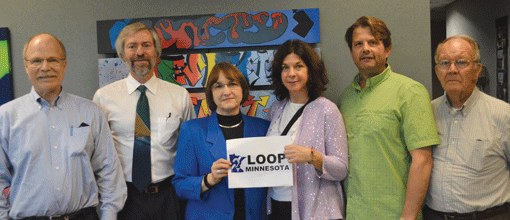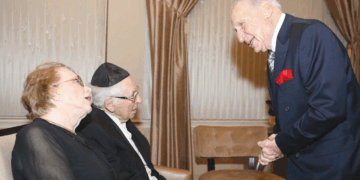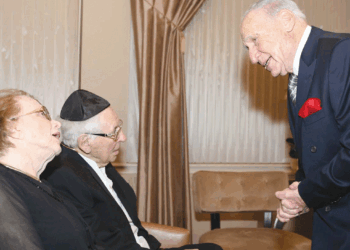The City of St. Louis Park recently installed a hearing loop with the help of Loop Minnesota, a new nonprofit organization
By ERIN ELLIOTT BRYAN / Community News Editor
For individuals who have any degree of hearing loss, spending time in place and at events with large groups of people can be difficult. Trying to hear in restaurants, town hall meetings and even religious services — amid a din of background noise — can be frustrating, to say the least.
According to audiologist Kim Fishman, of Chears Audiology in St. Louis Park, the Americans with Disabilities Act (ADA) requires auditoriums and other public spaces with 50 seats or more to provide assistive hearing devices. Most places maintain an FM system and offer headsets to those who ask for them.
Those types of systems, however, increase the levels of all noise, including background noise. They also require people to seek them out and are visible to everyone around them.
“It has to be charged up, you have to ask people where it is and you’re labeling yourself that you can’t hear,” Fishman told the AJW. “And it’s just giving an amplification, it’s not sloping the hearing loss to your prescription.”
But a device called an induction loop can amplify sound and eliminate or significantly decrease background noise for those who already have a qualifying hearing aid, without forcing them to wear another type of amplification device, such as a headset.
An induction loop is made up of a speaker, an amplifier and a wire that is installed around — or “loops” — a space, such as a large meeting room. When it is turned on, the amplifier sends an electromagnetic signal through the wire, which is picked up by the telecoil, or T-coil, that exists in approximately 65 percent of hearing aids.

The sound is amplified and sent directly to individual hearing aids. And when hearing aids are switched to the T-coil mode, they shut down the external microphone, eliminating most of the background noise. (Audiologists must program the T-coil to be functional, but then users can turn it on or off with a switch.)
“The benefit of having a loop is that your prescription is in your hearing aid,” Fishman said. “When you just push a little button for the T-coil, voilà, the sound comes right to your ear.”
Fishman is a member of Loop Minnesota, a nonprofit advocacy organization that is working to provide better hearing access in all public places. The group — which is comprised of audiologists, sound manufacturers and advocates of those with hearing loss — encourages the installation of induction loops, though its members can offer advice on other technologies.
“We do feel strongly that loop installations, for the most part, are the best technology in most conditions; however, we don’t limit ourselves to that,” said Rick Nelson, president of Loop Minnesota. “Really what it comes down to is, what’s the best technology and the most appropriate and cost effective for that venue.”
The organization has only existed for a few months, but it has already worked with the City of St. Louis Park to successfully loop its city council chambers. As far as Loop Minnesota members are aware, the city hall is the first in Minnesota to install an induction loop.
Brian Hoffman, St. Louis Park’s director of inspections, said the idea was first brought up in January and the system was operational in May. Though the cost — approximately $5,000 — was not included in the city’s capital improvement budget, it was paid for by operating funds and grants from Loop Minnesota and the Minnesota chapter of the Hearing Loss Association of America (HLAA).
“It was neat that it was able to move so fast, from just a concept idea that was raised to having it actually in and working,” Hoffman said.

And the system was beneficial almost immediately when one city council member revealed his own hearing loss. With the installation of the loop, he noticed a significant improvement in his ability to hear.
“That was totally coincidental, but it shows that a lot people may be using a hearing aid that you don’t know,” Hoffman said. “Now they come into the room and see the sign at the entrance, and they know that they have the ability to improve their hearing. I thought it was fantastic.”
Nelson pointed out that loops are beneficial for a variety of different spaces, including those that are privately owned, but publicly accessible. Employees of banks or pharmacies, for example, would not have to raise their voices to converse with people who experience hearing loss, which could violate their privacy if others can hear that conversation.
“They can loop anything, you could loop an office, a meeting room or a teller’s counter, and really give that person a better shot at hearing,” Nelson said. “Any time you can cut down background noise and have somebody literally talking into your ears, it’s going to improve your chances of understanding what they’re saying. There’s so many different installations that you can think about and I don’t think most people realize that.”
Loop Minnesota is working to raise money through donations and sponsorships, which will help with the installation of additional loops throughout the state. The organization also welcomes individuals to become advocates and help spread the word about this technology.
“We want more advocates with hearing loss because they can’t hear somewhere,” Fishman said. “We want people who can’t hear and are having trouble to step up and advocate for themselves.”
***
Interested individuals are invited to join Loop Minnesota’s next monthly meetings, which will take place 11:30 a.m. Fridays, July 18 and Sept. 12 in the St. Louis Park City Council Chambers, 5005 Minnetonka Blvd. There will be no August meeting due to summer break.
For information, visit: www.loopminnesota.org.
(American Jewish World, 7.4.14)












